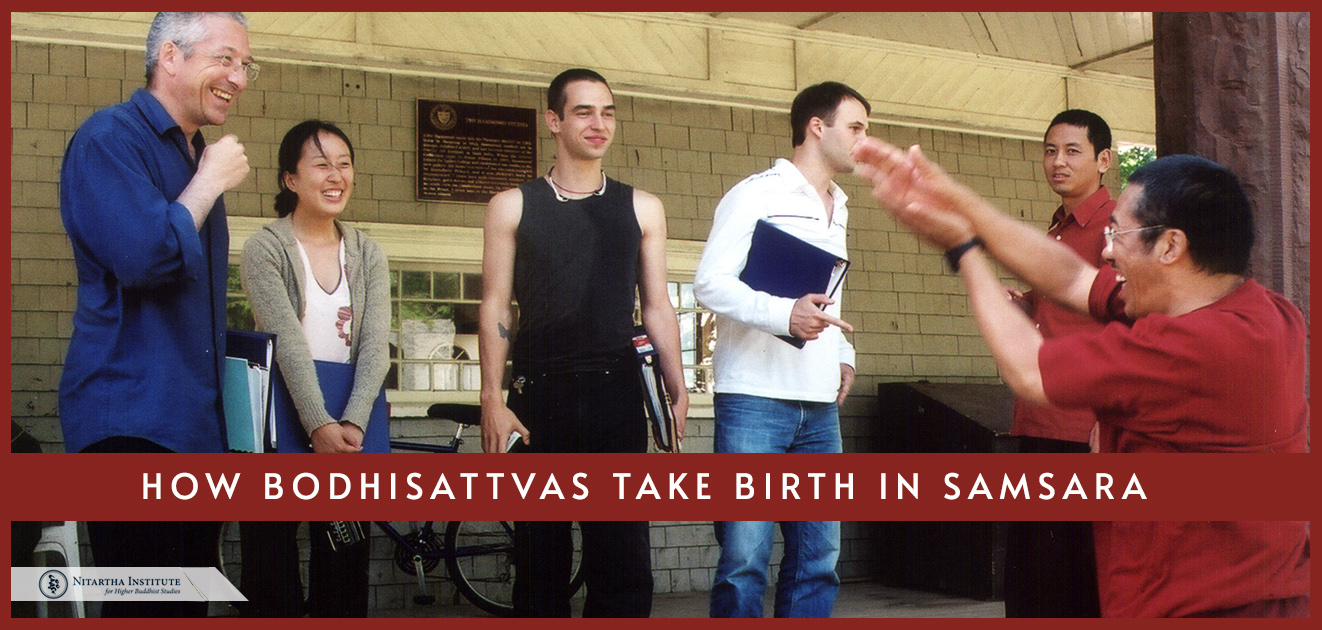This excerpt is copyrighted material, please do not use or copy without written permission from Nitartha Publications.
This is an excerpt from the sourcebook we use in our Buddha Nature course. This course is part of Level 4, along with Cittamatra. The teachings on Buddha Nature present an overview of the Tathāgatagarbha, or Buddha Nature tradition, the view of the luminous essence of awakening, the heart of goodness shared by all beings. Our exploration will rely on the key section of Uttaratantra of Maitreya (ca. 4th century) which establishes Buddha nature through three reasonings, its ten facets, nine analogies and five reasons why it is necessary to teach it.
How Bodhisattvas Take Birth in Saṃsāra
Acharya Lama Tenpa Gyaltsen
In the beginning of the Gyü Lama text, we saw that there were ten divisions that helped us to determine buddha nature. We have looked at the essential nature, the cause, and the fruition. To recap in brief: We saw that there were four aspects to the cause and four aspects to the result, or the four perfections. These four were condensed into the prajñā that realizes no-self and loving-kindness and compassion. Thus, with these two, it is possible to attain nonabiding nirvāṇa, or dynamic nirvāṇa.
When we are practicing Mantrayāna or Mahāyāna, we need both the prajñā that realizes no-self and compassion. Prajñā alone or compassion alone will not work. Why? Because if we do not have prajñā, we will not be able to liberate ourselves from saṃsāra. Because we are not able to cut through the roots of saṃsāra, or eradicate what it is that holds us within saṃsāra, there can be no liberation from saṃsāra. Therefore, without prajñā, we fall into the limitation of saṃsāric existence. However, it is not just a question of freeing ourselves from saṃsāra; we need also to help other sentient beings. Without compassion, it is not possible to help other sentient beings. Therefore, without compassion, we fall into the extreme of pacification or tranquility. This extreme of pacification is seen as a fault, and it is to be refuted or negated. We need compassion so as not to fall into this kind of extreme or wrong view. Thus, on this Mahāyāna or Mantrayāna path, we need both prajñā and compassion.
According to the philosophical system presented in the Gyü Lama, there is a distinction between cycling around in saṃsāra and taking rebirth in saṃsāra. What is the cause for cycling in saṃsāra? It is grasping to a self, or ego-fixation, and ignorance. It is also referred to as “the obscuration of the kleshas” or “the obscuration of the afflictions.” When we directly realize no-self, both grasping to a self and ignorance are eliminated. We can see that a bodhisattva who is abiding on the bhūmis does not have the cause for this kind of birth in saṃsāra. He or she has the remedy for the cause of birth in saṃsāra, the grasping onto a self. This is the remedy of the prajñā that realizes no-self.
One might ask whether the bodhisattvas who abide on the bhūmis take birth in saṃsāra or not? There is a debate about this point. Some say, for example, that bodhisattvas abiding on the first bhūmi have gotten rid of the cause for taking birth in saṃsāra because they have eliminated grasping onto a self. According to the explanation found in the Gyü Lama, bodhisattvas who abide on the bhūmis have given up the cause for cycling in saṃsāra, but they have not given up the cause for taking birth in saṃsāra. A distinction is made between cycling in saṃsāra and taking birth in saṃsāra. The people who take the position that bodhisattvas cannot take rebirth in saṃsāra because they have given up the cause do not understand that to take birth in saṃsāra one needs ignorance, and the bodhisattvas have given that up. Therefore, they do not take this first kind of birth.
To understand the difference, we have to look in detail at the subtle points of this view in the Gyü Lama and at what is said in other texts. Other texts that say bodhisattvas take birth in saṃsāra because they have not given up all the kleshas. It is said that up to the sixth bhūmi, bodhisattvas still have afflictions, and because of that, they take birth within saṃsāra. According to this view, bodhisattvas fall into saṃsāra or are reborn in the cycle of saṃsāra until they attain the seventh level bhūmi. Until that point, they have not given up the obscuration of kleshas.
According to the thought of the Gyü Lama, bodhisattvas who have attained the first bhūmi do not cycle within saṃsāra because they have given up the cause for that cycling. The cause for that cycling is a birth brought about through karma and kleshas. Ordinary beings, beings who have not attained the first level, usually take birth through the force of karma and kleshas. Bodhisattvas, however, take birth in different ways: through the power of compassion, through the power of aspiration prayers, and through the power of samādhi. These are the causes for bodhisattvas taking birth.
Another question arises relative to the path of seeing, which is also the first bhūmi: Have all the obscurations of kleshas been given up on this first level?
There are four kinds of births: the first type is the birth of ordinary beings, the second type is birth caused by the power of compassion, the third type is birth by compassion combined with samādhi, which causes bodhisattvas on the first to the sixth bhūmi to take rebirth, and the fourth type is birth through aspiration prayers, which causes bodhisattvas from the seventh to the tenth level to take rebirth. These are the distinctions that are made. For the last three types, one can see that bodhisattvas do not take rebirth through the power of karma and kleshas.
Another question arises relative to the path of seeing, which is also the first bhūmi: Have all the obscurations of kleshas been given up on this first level? The answer is no. There are still kleshas to be given up. It is said that from the first to the sixth level, one simultaneously discards the klesha obscurations and the cognitive obscurations, which are also sometimes called “obscurations to omniscience.” Together, those two obscurations are given up as the bodhisattvas move from the first up to the sixth level. At the seventh bhūmi, they have completely given up the kleshas. Only the very subtle cognitive obscurations are left at that point. Those are eliminated at the tenth level by vajralike samādhi, after which the bodhisattvas enter the level of buddhahood, or the level of union. The ten levels are divided according to the distinction of pure or impure bhūmis. It is said that the first to the sixth levels are the impure bhūmis because the obscurations of kleshas are still present, and that the seventh to the tenth levels are the three pure bhūmis.
There is another question put forth in debate: Since there are kleshas from the first level to the sixth level, doesn’t it follow those kleshas are the cause of cycling in saṃsāra? The obscurations of kleshas function as an obstruction to attaining liberation, and since these bodhisattvas of the first to the sixth level have the obscurations of kleshas, they have not obtained liberation. Therefore, it follows that these bodhisattvas are still circling around in saṃsāra. The answer according to Lodrö Thayé’s explanation in the Gyü Lama is that although there are these kleshas, their power has been conquered, or pacified. For the bodhisattvas from the first to the sixth bhūmis, there is something like the klesha obscurations present, but their capacity or power to increase is exhausted. The example given is a cup full of poison. If you take some kind of chemical that will nullify the effect of the poison and pour it into the poison, the poison will no longer have the ability to act as a poison. The liquid that was present before it was nullified is still present in the cup, but it does not have the power to function as poison anymore. Klesha obscurations for the bodhisattvas from the first to the sixth bhūmi are similar. From the outside, kleshas appear to be present, but they have lost their power.





